Top Management Books
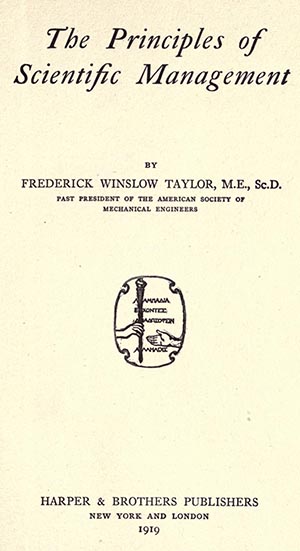
12 min read ⌚
The discipline of management is “one of the greatest social innovations of modern times”. In fact, the idea of managing processes is so ubiquitous and pervasive, that Peter Drucker, “the founder of modern management,” considers managers nothing short of the present and future torchbearers of ethics and morality.
You can read why he thinks that in our review of one of the two books we included in our top management books list. We believe that the other thirteen are as important and famous, as influential and eye-opening.
And we don’t want to lose you another second of your time before we introduce our picks for the 15 best management books in history.
#1. “The Principles of Scientific Management” by Frederick Winslow Taylor
 In 1913, V. I. Lenin, the man who would go on to start a bloody revolution four years later, wrote in “Pravda” that “the most widely discussed topic today in Europe, and to some extent in Russia, is the ‘system’ of the American engineer, Frederick Taylor.”
In 1913, V. I. Lenin, the man who would go on to start a bloody revolution four years later, wrote in “Pravda” that “the most widely discussed topic today in Europe, and to some extent in Russia, is the ‘system’ of the American engineer, Frederick Taylor.”
What Lenin was referring to was a 1911 monograph titled “The Principles of Scientific Management,” a highly influential work during the period of the Progressive Era (1890-1920), written by a man whose life mission was improving industrial efficiency, Frederic Winslow Taylor.
Even though the essay expounds theories which would grow obsolete in the meantime, generally the book’s influence is highly regarded even in the 21st century. In fact, in 2001, the 137 Fellows of the Academy of Management voted it the most influential management book ever written.
And some of its main ideas are still hotly and commonly debated. Such as the suggestion that shorter workdays may still increase productivity. What do you think?
#2. “The Functions of the Executive” by Chester Barnard
 During the same Academy of Management survey which voted “The Principles of Scientific Management” the most influential management work in history, Chester Irving Barnard’s 1938 classic “The Functions of the Executive” came in second.
During the same Academy of Management survey which voted “The Principles of Scientific Management” the most influential management work in history, Chester Irving Barnard’s 1938 classic “The Functions of the Executive” came in second.
Considered “the first paradigmatic statement of the management discipline,” “The Functions of the Executive” presents “a theory of organization and cooperation,” much in the same manner as Taylor. However, the big difference between them is that Barnard didn’t want to merely prescribe principles; he wanted to study those already practiced and compare them to each other to discover the best practice.
Divided into four parts and eighteen chapters, Barnard’s book is a somewhat difficult read. Just looking at the titles of the parts is enough. The first one, for example, is called “Preliminary Considerations Concerning Cooperative Systems”; the last one: “The Functions of Organizations in Cooperative Systems.”
However, have no doubts whatsoever that, in this case, looking past the “atrocious” style is more than worth it.
#3. “The Essential Drucker” by Peter Drucker
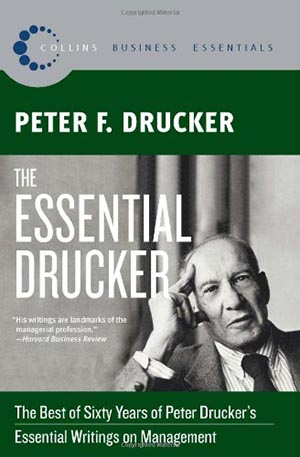 Born in the Austro-Hungarian Empire few years before it dissolved, Peter Drucker, “the most influential and widely read authority on modern organizations,” had the invaluable privilege to be raised in a household where intellectuals, scientists, and leaders regularly met to discuss their views and ideas.
Born in the Austro-Hungarian Empire few years before it dissolved, Peter Drucker, “the most influential and widely read authority on modern organizations,” had the invaluable privilege to be raised in a household where intellectuals, scientists, and leaders regularly met to discuss their views and ideas.
If you’re wondering about their names and reputations, just have a look at our top economics booklist: any Austrian you’ll find there (and there are few), Peter Drucker personally knew even as a child.
In the final Academy of Management list of most influential books, Drucker’s 1954 “The Practice of Management” was listed third and called a “seminal contribution” to the field. However, for our list, we opted for two different books, even though, really, Drucker is so omnipresent that we’ll always stand by our recent estimation that he is “as important to companies, as oxygen is crucial for our survival.”
“The Essential Drucker” is a carefully compiled collection of the 26 most important writings by Drucker, and, as such, is an essential read for every manager.
#4. “Management: Tasks, Responsibilities, Practices” by Peter Drucker
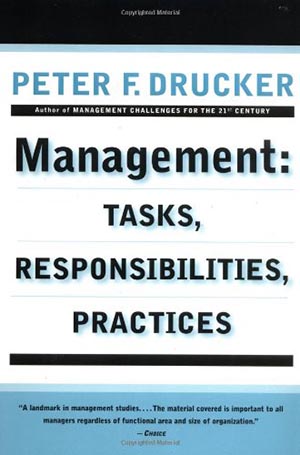 If you’ve studied management at almost any university, the chances are this was one of the first – if not the first – book you were assigned as a compulsory read.
If you’ve studied management at almost any university, the chances are this was one of the first – if not the first – book you were assigned as a compulsory read.
Originally published in 1973, “Management: Tasks, Responsibilities, Practices” is still the best management manual almost half a century later. And it’s so all-encompassing and diligently organized that it’s difficult to see how any other book can take its place.
Developed and written during a period of over three decades, “Management” draws heavily on Peter Drucker’s experience as a management professor and consultant to government agencies, and large and small businesses. In fact, you can consider this book a distillate of his life. There’s everything here! From basic management tasks to best management practices.
But, don’t ignore Drucker’s pleas for business ethics either. “In modern society,” he writes, “there is no other leadership group but managers. If the managers of our major institutions, and especially of business, do not take responsibility for the common good, no one else can or will.”
#5. “What Management Is: How It Works and Why It Is Everyone’s Business” By Joan Magretta
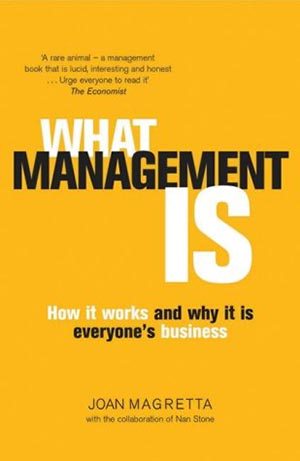 The blurb to “What Management Is” may sound a bit pretentious, but, trust us, it exaggerates nothing. “Not since Peter Drucker’s great work of the 1950s and 1960s,” it says at one point, “has there been a comparable effort to present the work of management as a coherent whole, to take stock of the current state of play, and to write about it thoughtfully for readers of all backgrounds.”
The blurb to “What Management Is” may sound a bit pretentious, but, trust us, it exaggerates nothing. “Not since Peter Drucker’s great work of the 1950s and 1960s,” it says at one point, “has there been a comparable effort to present the work of management as a coherent whole, to take stock of the current state of play, and to write about it thoughtfully for readers of all backgrounds.”
And when it says “all backgrounds” – trust us yet again – it really means so! At no more than 256 pages, Joan Magretta has managed to achieve a rare feat. Namely, to write a book which may attract the interest of both novices and experienced managers; teaching the former the basics and providing the latter with encyclopedically organized body of knowledge.
The beginners will additionally love the simplicity with which Magretta explains complex management ideas; and, even more, the clear, concise, and straight-to-the-point style. As “The Econimist” review put it best: “a rare animal: a management book that is lucid, interesting and honest.”
#6. “First, Break All the Rules: What the World’s Greatest Managers Do Differently” by Marcus Buckingham and Curt Coffman
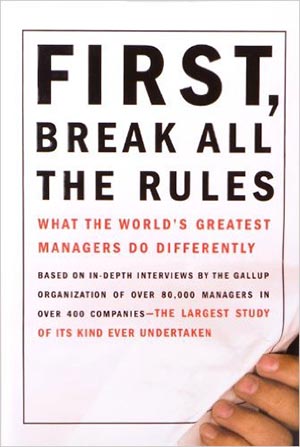 In 2011, “Time Magazine” made a list of “The 25 Most Influential Business Management Books.” We bet few would have been surprised to see there Marcus Buckingham’s and Curt Coffman’s brilliant “First, Break All the Rules.”
In 2011, “Time Magazine” made a list of “The 25 Most Influential Business Management Books.” We bet few would have been surprised to see there Marcus Buckingham’s and Curt Coffman’s brilliant “First, Break All the Rules.”
Published by Gallup, the book is based on the largest management survey ever undertaken, encompassing 80,000 interviewed managers from over 400 successful companies. Buckingham and Coffman asked each of the managers 12 simple questions; then they thoroughly studied the answers. The results are staggering: almost none of the old management techniques actually work in practice.
What does work?
Well, first of all, treating employees like individuals capable of doing seriously difficult work; and focusing on their strengths rather than their weakness; however, all the while not believing that with training everyone can do what he or she sets his or her mind to.
It seems that setting specific outcomes works; but – believe it or not – refraining from setting specific processes does as well. Disregarding the golden rule – is the golden rule.
And much, much more.
#7. “Now, Discover Your Strengths” by Marcus Buckingham and Donald O. Clifton
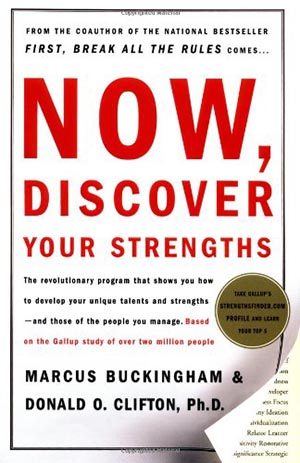 So much more, in fact, that Marcus Buckingham went on to write another work, a companion-piece to “First, Break All the Rules”. This time with a new co-author – American psychologist Donald O. Clifton, – but using the very same methodology. And, based on the titles, we have a feeling that this one’s was in preparation even before the first one was published.
So much more, in fact, that Marcus Buckingham went on to write another work, a companion-piece to “First, Break All the Rules”. This time with a new co-author – American psychologist Donald O. Clifton, – but using the very same methodology. And, based on the titles, we have a feeling that this one’s was in preparation even before the first one was published.
We already featured “Now, Discover Your Strengths” in our top motivational books, but we think it belongs here as well. Based on a gargantuan survey by The Gallup Organization, the book quantifies the answers 1.7 million interviewees gave to several questions, and deduces the 34 distinct “talent themes” (or traits), the combinations of which can best describe an individual’s uniqueness.
And after helping each reader to find his specific strengths – via Gallup’s strengthfinder.com online resource – “Now, Discover Your Strengths” offers many practical advices on how to advance and employ them.
Updated as “Strengths Finder 2.0” in the meantime, this book can teach managers to get the best out of their employees, and employees get the best out of themselves.
#8. “Good to Great: Why Some Companies Make the Leap… and Others Don’t” by James C. Collins
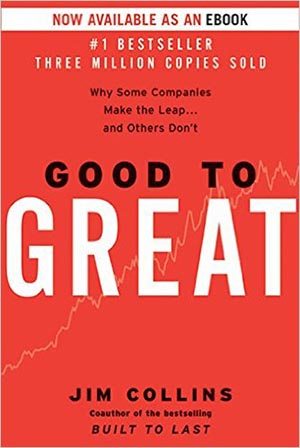 In our microsummary, we described “Good to Great” as “one of the best management books to ever see the light of day. So, obviously enough, we include it in our list of top management books in history.
In our microsummary, we described “Good to Great” as “one of the best management books to ever see the light of day. So, obviously enough, we include it in our list of top management books in history.
Published in 2001, “Good to Great” tries to answer the question why some good companies succeed in becoming great, while others simply fail making the leap mentioned in the title. And, just like our two previous books on this list, “Good to Great” is not merely a theoretical exposé, but is based on an expansive 5-year study.
But, then again, if you know anything about its author, Jim Collins, you would have known that from the start.
Ultra-successful book and selling more the 4 million copies, “Good to Great” compares eleven great companies to their merely good counterparts (e.g. Philip Morris vs. R. J. Reynolds) and discovers seven characteristics which the former had and the latter didn’t.
And let’s face it: who wouldn’t want to know them?
#9. “Built to Last: Successful Habits of Visionary Companies” by James C. Collins and Jerry I. Porras
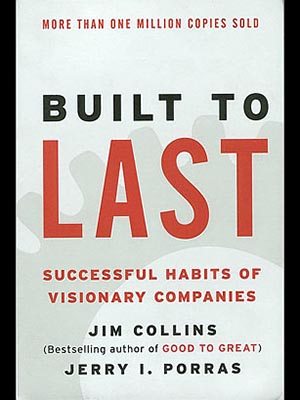 “Good to Great” was published in 2011 and, as we wrote above, received enormous amounts of attention. However, it wasn’t without a precedent: by that time, in fact, Jim Collins would have already made his name as one of the leaders in the field with “Built to Last.”
“Good to Great” was published in 2011 and, as we wrote above, received enormous amounts of attention. However, it wasn’t without a precedent: by that time, in fact, Jim Collins would have already made his name as one of the leaders in the field with “Built to Last.”
Originally published in 1994, “Built to Last” is, once again, based on a wide-ranging six-year research project at the Stanford University Graduate School of Business. Its two main goals – in its authors’ words – were ““to identify underlying characteristics are common to highly visionary companies” and “to effectively communicate findings so they can influence management.”
And “Built to Last” lives up to both of these high expectations.
By carefully studying the ideas and the practice of 18 widely admired companies founded before 1950, “Built to Last” provides valuable insights into the management habits of these great companies and deduces what made them so exceptional by comparing them to their top competitors.
Defining and seminal, “Built to Last” lives up to its title.
Like this summary? We’d like to invite you to download our free 12 min app, for more amazing summaries and audiobooks.
#10. “In Search of Excellence: Lessons from America’s Best-Run Companies” by Thomas Peters and Robert H. Waterman
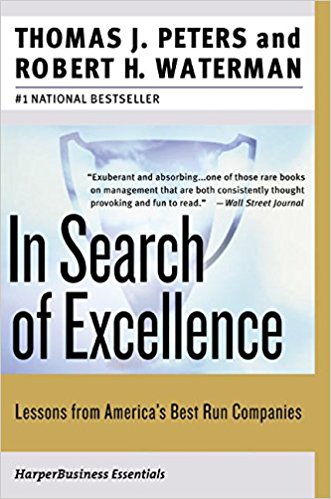 Published in 1982, “In Search of Excellence,” brought Tom Peters and Robert H. Waterman Jr. so much attention that even though it was their debut book they quickly got nation-wide coverage and some flattering epithets of the “business guru” kind.
Published in 1982, “In Search of Excellence,” brought Tom Peters and Robert H. Waterman Jr. so much attention that even though it was their debut book they quickly got nation-wide coverage and some flattering epithets of the “business guru” kind.
Three decades later, it’s obvious that the initial evaluations were correct. “In Search of Excellence” is still considered a management manual.
Started as a study of 62 businesses, it ended up as a thorough analysis of the management practices in the 43 best-run companies in the United States. By carefully examining the available data, Peters and Waterman discovered that the companies which succeed share eight common characteristics.
And “In Search of Excellence,” they dedicate a chapter to each. Unsurprisingly, in the meantime, these eight traits have become basic principles of management.
Dubbed the “Greatest Business Book of All Time” by “Bloomsbury UK,” “In Search of Excellence” is the fourth best-selling management book in history, trailing only Carnegie’s “How to Win Friends and Influence People” and the books at #4 and #8 on this list.
#11. “Competing for the Future” by Gary Hamel, C. K. Prahalad
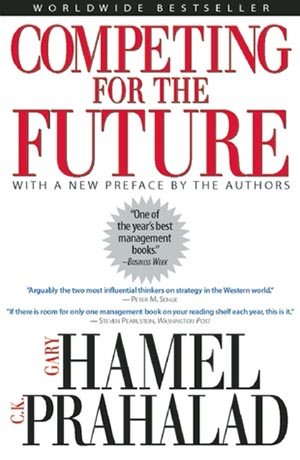 Soon after its publication, in a review for “Washington Post,” Steven Pearlstein wrote that “if there is room for only one management book on your reading shelf each year”, “Competing for the Future” is his 1996 choice. “Business Week” backed Pearlstein’s decision, claiming that it’s “one of the year’s best management books.”
Soon after its publication, in a review for “Washington Post,” Steven Pearlstein wrote that “if there is room for only one management book on your reading shelf each year”, “Competing for the Future” is his 1996 choice. “Business Week” backed Pearlstein’s decision, claiming that it’s “one of the year’s best management books.”
Exciting and profoundly valuable, “Competing for the Future” is written by two renowned thinkers on strategy, Gary Hamel and Coimbatore Krishnarao Prahalad. And it strives to give “would-be revolutionaries” the tools to challenge “the protectors of the past.
As any book written for rebels, it challenges many of the notions about management prevalent at the day; if you think that most of them are commonsensical now – well, you owe it to Hamel’s and Prahalad’s expertise.
And you certainly do think that strategic planning is a continuous process and that it is something that has to encompass the whole organization, and not just some sectors, right?
#12. “Six Thinking Hats: An Essential Approach to Business Management” by Edward De Bono
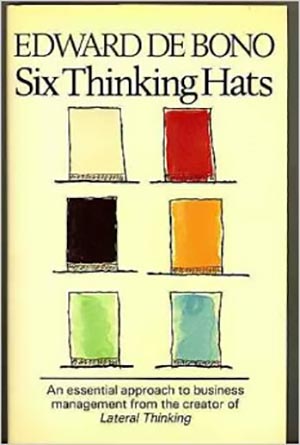 You can really argue that Edward de Bono is one of the most famous exports from the tiny island nation of Malta. Psychologist, philosopher, physician, and inventor, he is the man who invented the concept of lateral thinking, i.e. solving problems creatively.
You can really argue that Edward de Bono is one of the most famous exports from the tiny island nation of Malta. Psychologist, philosopher, physician, and inventor, he is the man who invented the concept of lateral thinking, i.e. solving problems creatively.
And “Six Thinking Hats” is the book where he first proposed the idea.
Published in 1985, “Six Thinking Hats” devised a thinking system which strives to eradicate the most serious problem of thinking: confusion. De Bono demonstrates that confusion stems from the fact that we’re never thinking clearly, or, rather, that we’re always using many aspects of our being to think.
So, he suggests a role-playing method which clarifies how thinking works, by splitting the process into its six comprising elements.
The red hat is the emotional one, while the white one shows interest in facts only; the black one is the devil’s advocate, while the yellow is the optimistic hat; finally, the green hat is the hat of creativity, and the blue one – the hat of the manager.
Employed by many companies even today, de Bono’s three-decades-old tool has proved a lasting success!
#13. “The Great Game of Business: The Only Sensible Way to Run a Company” by Jack Stack
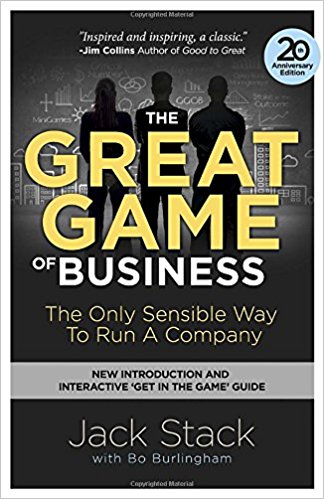 This is a book about an inspirational story.
This is a book about an inspirational story.
Springfield Remanufacturing Corporation was founded in 1983 by 13 employees of International Harvester. In an attempt to save 119 jobs, they decided to buy the part of the company which rebuilt truck engines. How? With $100,000 of their own money. And about $8.9 million in loans!
Led by Jack Stack, the employees turned the things around, and the initial stock price of $0.10 in 1983 had increased by almost 2,000 times and was worth over $199 per share in 2015.
And we still haven’t gotten to the most interesting part of the story! You see, Jack Stack had neither experience nor an idea how to manage a company!
So, how did he do it?
“The Great Game of Business” explains what he did in detail, introducing to the world the fairly new concept of “open-book management.” Its main premise, especially in view of capitalistic doctrines, is staggeringly innovative.
Namely, Springfield Remanufacturing is not managed by one person, but by everybody. In other words, everyone has his or her say on each financial decision and all company matters.
And – well – somehow it works brilliantly!
#14. “Out of the Crisis” by W. Edwards Deming
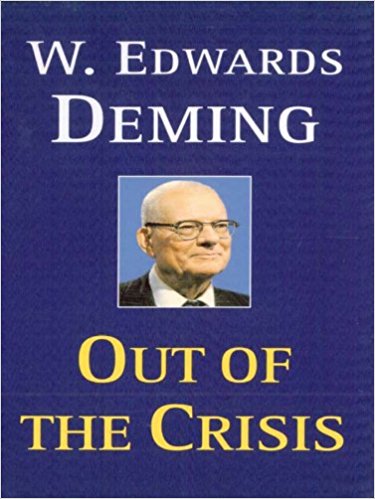 Originally published by MIT Center for Advanced Engineering in 1982 as “Quality, Productivity, and Competitive Position,” this W. Edwards Deming’s classic was republished in 1986 under its much more friendly current title, “Out of Crisis.”
Originally published by MIT Center for Advanced Engineering in 1982 as “Quality, Productivity, and Competitive Position,” this W. Edwards Deming’s classic was republished in 1986 under its much more friendly current title, “Out of Crisis.”
The book, included in both “Time Magazine’s” “and Academy of Management’s” lists of top 25 most influential management books in history, is widely credited with introducing the concept of Total quality management, even though Deming never actually uses the term in the book.
However, he does offer 14 key principles to managers which articulate TQM in both simple and still operational manner.
Ranging from ideas about the necessity of improving constantly and forever to suggestions that breaking down barriers between departments is a must, from calls to put an end to inspections to requests to drive out fear from the workplace, “Out of the Crisis” has transformed many companies in the past four decades.
And will certainly transform you once you find the time to read it.
#15. “The One Minute Manager: The Quickest Way to Increase Your Own Prosperity” by Kenneth Blanchard and Spencer Johnson
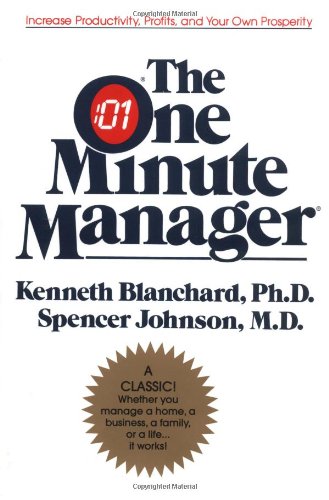 The subtitle of this book – “the quickest way to increase your own prosperity” – seems like an understatement when compared to the title – “The One Minute Manager.”
The subtitle of this book – “the quickest way to increase your own prosperity” – seems like an understatement when compared to the title – “The One Minute Manager.”
Of course, those who expect to become good managers in one minute expect a bit much. But, even they might be absolutely flabbergasted by the fact that Kenneth Blanchard and Spencer Johnson need no more than a hundred pages to expound upon a simple management concept which ended up influencing thousands of companies.
And especially by the main premise of the book: one minute to a manager may be an exaggeration, but three minutes is just about right!
A sleeper hit in the 1980s, “The One Minute Manager” is, in fact, a fable explicating a management-by-objectives type of managing which is based around the idea an effective manager sets one-minute goals, and sets aside one minute for praising and one minute for reprimanding his employees.
A business bestseller ever since its publication, “The One Minute Manager” is, both literally and metaphorically, a small wonder.








